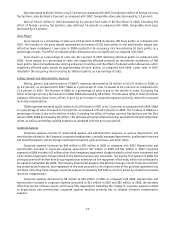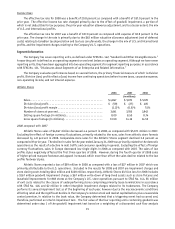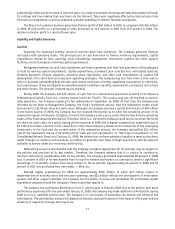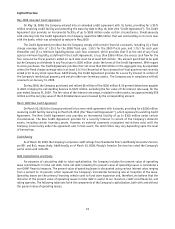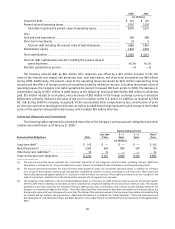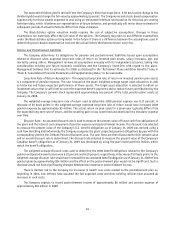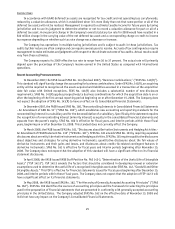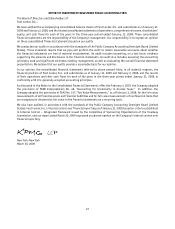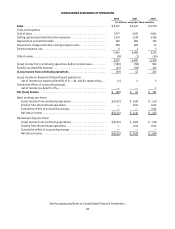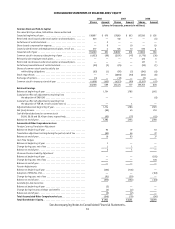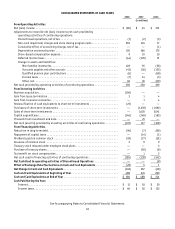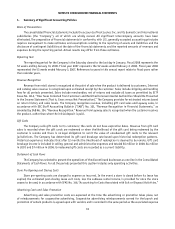Foot Locker 2008 Annual Report Download - page 39
Download and view the complete annual report
Please find page 39 of the 2008 Foot Locker annual report below. You can navigate through the pages in the report by either clicking on the pages listed below, or by using the keyword search tool below to find specific information within the annual report.
23
The Company assigned discount rates ranging from 12 to 14 percent for the four reporting units. The Company
evaluated the merits of each significant assumption, both individually and in the aggregate, used to determine the
fair value of the reporting units, as well as the fair values of the corresponding assets and liabilities within the
reporting units, and concluded they are reasonable and are consistent with prior valuations.
Owned trademarks and tradenames that have been determined to have indefinite lives are not subject to
amortization but are reviewed at least annually for potential impairment in accordance with SFAS No. 142, as mentioned
above. The fair values of purchased intangible assets are estimated and compared to their carrying values. We estimate
the fair value of these intangible assets based on an income approach using the relief-from-royalty method. This
methodology assumes that, in lieu of ownership, a third party would be willing to pay a royalty in order to exploit the
related benefits of these types of assets. This approach is dependent on a number of factors, including estimates of
future growth and trends, royalty rates in the category of intellectual property, discount rates and other variables. We
base our fair value estimates on assumptions we believe to be reasonable, but which are unpredictable and inherently
uncertain. Actual future results may differ from those estimates. We recognize an impairment loss when the estimated
fair value of the intangible asset is less than the carrying value.
We consider many factors in evaluating whether the carrying value of goodwill may not be recoverable, including
declines in stock price and market capitalization in relation to the book value of the Company and macroeconomic
conditions affecting retail. In the last few months of 2008 and into 2009, the capital markets experienced substantial
volatility and the Company’s stock price declined substantially, causing the Company’s book value to exceed its
market capitalization. Accordingly, we concluded that a triggering event had occurred. During the fourth quarter of
2008, the Company performed an analysis of its goodwill and other intangibles.
Based on the results of step one, the fair values of the Direct-to-Customers and Foot Locker Europe reporting
units exceeded their carrying values, indicating that there was no impairment of goodwill at these reporting units.
The discount rates would have to be increased to over 17 percent before the fair values of these reporting units would
be less than their carrying values. The Company does not believe the resulting discount rates would be reasonable
relative to the risks associated with the future cash flows of these reporting units. The results of both the income and
market approaches indicated that the fair values were in excess of the carrying values. The Company has applied these
approaches consistent with prior valuations.
However, the fair values of the Foot Locker, Kids Foot Locker and Footaction reporting unit and the Champs Sports
reporting unit indicated a potential impairment. The decline in the fair values of these reporting units reflected lower
expected sales and cash flows as a result of the macroeconomic environment and uncertainty around future cash flows.
The Company completed the second step where the fair value of the reporting unit is allocated to all of the assets
and liabilities of the reporting unit to determine an implied goodwill value. This allocation is similar to a purchase
price allocation performed in purchase accounting. If the carrying amount of the reporting unit’s goodwill exceeds
the implied goodwill value, an impairment loss should be recognized in an amount equal to that excess. Accordingly,
the Company determined that the goodwill assigned to these reporting units were fully impaired. Additionally, the
Company performed a reconciliation of its market capitalization to the total fair value. The principal reconciling item
was ascribed to a control premium associated with the consolidated businesses that would not be reflected in public
market trading prices.
The Company’s review of goodwill and other intangibles resulted in impairment charges totaling $169 million.
Share-Based Compensation
The Company estimates the fair value of options granted using the Black-Scholes option pricing model. The
Company estimates the expected term of options granted using its historical exercise and post-vesting employment
termination patterns, which the Company believes are representative of future behavior. Changing the expected term
by one year changes the fair value by 3 to 5 percent depending if the change was an increase or decrease to the expected
term. The Company estimates the expected volatility of its common stock at the grant date using a weighted-average
of the Company’s historical volatility and implied volatility from traded options on the Company’s common stock. A 50
basis point change in volatility would have a 2 percent change to the fair value. The risk-free interest rate assumption
is determined using the Federal Reserve nominal rates for U.S. Treasury zero-coupon bonds with maturities similar to
those of the expected term of the award being valued.


